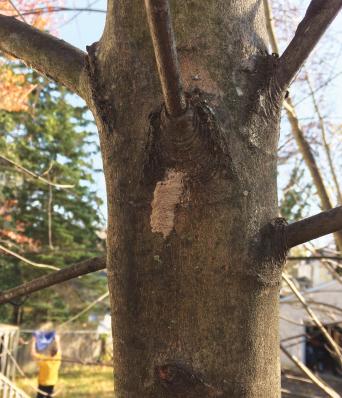Join the Fight Against the Spotted Lanternfly By Taking Photos of Egg Masses This Winter
Was your neighborhood full of spotted lanternflies this fall? If so, now is the time to fight back! Researchers from Drexel University and the Academy of Natural Sciences are developing technology for early detection of lanternfly egg masses and are looking for citizen scientists to help develop the technology by contributing photographs of the egg masses to a shared photo album.
The gray adult lanternflies that came in swarms this fall died with the frost, but their eggs can survive the cold. When the nymphs hatch in the spring, they will start sucking the sap of many local crops, such as grapes, apples and peaches. Research from Pennsylvania State University has shown that lanternflies reduce fruit yields and can completely kill grapevines. Moreover, farmers and homeowners who use pesticides to kill lanternflies may accidentally poison pollinators.
If lanternflies lay their eggs on trains, car, or cargo, they can spread the infestation over long distances; this is almost certainly how they came to Pennsylvania in the first place. Right now, businesses that travel in and out of the lanternfly infestation area are required to inspect for eggs on their vehicles and cargo. However, it can be difficult or even dangerous for individuals to look in some places, such as underneath vehicles. Using cameras and computer vision to inspect for egg masses could be safer, cheaper and more effective.
Computer vision is the technology behind facial recognition in security cameras and text extraction in online banking. Through this technology, computers learn to recognize objects by being shown many examples. In artificial intelligence research, this is called “training data.” More training data makes algorithms more accurate. Consequently, collecting more pictures of lanternfly eggs increases the odds of developing successful algorithms that can be used by businesses or inspectors.
A cellphone picture of eggs is enough to help. Eggs are often found on the sheltered underside of tree branches, deck railings or shed roof overhangs. Look for red maples (often planted around parking lots), silver maples, birch and tree-of-heaven, which can often be found growing in empty lots or disturbed areas.
Finally, egg-photo hunting can be a safely distanced outdoor activity, and it is a good way to get kids outside and active in the winter. Who knows — participating might even inspire future engineers to environmental action!
You can find out more and get involved at https://ansp.org/get-involved/science-at-the-academy/spotted-lanternfly/
Maureen Tang is an associate professor of chemical engineering at Drexel University. She can be reached at mhtang@drexel.edu.

